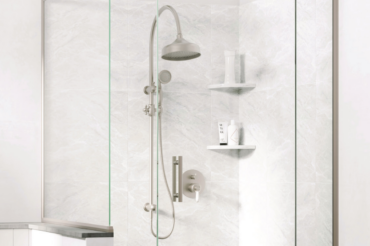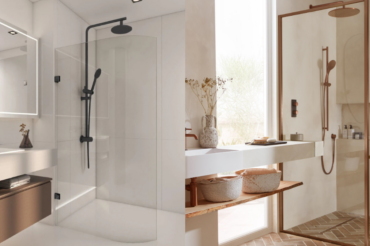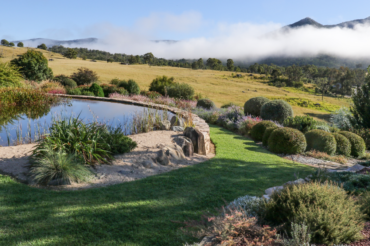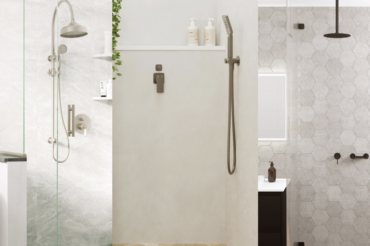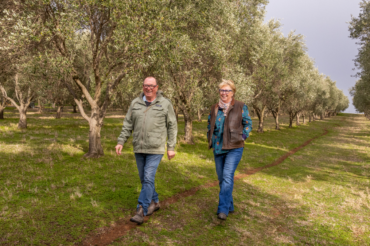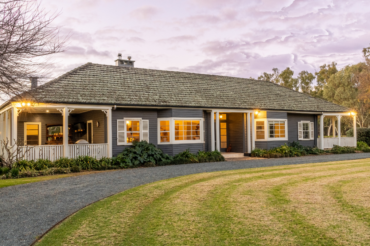
Prue and John Van de Linde have brought decades of experience in landscaping and horticulture in creating a showpiece garden in Victoria.

It’s hard to imagine now but, in 1997, when John and Prue Van de Linde bought a 50-acre ( 20-hectare ) run-down former horse stud near Yarra Glen in Victoria’s Yarra Valley, they started with about five trees in a blackberry-infested paddock.

These days, Alowyn Gardens is a stunning display garden, divided geometrically into areas devoted to French Provincial plantings, fruit, herbs and vegetables, casuarina and birch forests, a parterre section, a Zen area, a dry garden and a stunning 100-metre-long wisteria arbour. Water features, sculptures and other structures add interest throughout and there’s also a plant nursery and cafe in the grounds. The 10-acre (four-hectare) garden is bordered by John’s ‘legacy project’, an oak forest – still a work in progress – that’s his attempt to highlight the importance of trees as mitigation against climate change.

Alowyn has been a labour of love for John and Prue, who both have long careers in landscaping and horticulture. John grew up in Holland, where his parent were farmers and orchardists. He studied horticulture and came to Australia at the age of 19 where he worked in nurseries and vegetable farms, before moving to Melbourne where he took a job with a large plant wholesaler. John started his own landscaping business, Jay Vee Landscaping, in the Melbourne suburb of Box Hill in 1982. Prue grew up on a sheep farm at Gisborne in the Macedon Ranges, also studied horticulture and moved into the design side of the business. She met John when he asked her to do some drawing work and she realised she spent “way more hours on the job than it was worth”. They teamed up in 1990 and have been life and work partners ever since.

They bought Alowyn – named for a combination of one of John’s given names, Aloysius, and Prue’s given name, Olwen – for two reasons. “The first was that it’s difficult to operate a landscaping business from a residential site,” John explains. “We needed more space to store materials and equipment and grow our own plants.

“The second was that we had the idea of establishing a display garden, a bit like a housing estate display village or a permanent version of the Melbourne International Flower & Garden Show with other landscape and garden businesses leasing plots on the property. But that proved unviable, mainly due to the fact that we had limited water and electricity access.”

As mains water from Melbourne stops at a roundabout just down the road from Alowyn, the Van de Lindes rely on dams and ponds to water the site. They’ve devoted considerable time and energy to contouring the land to direct rain water into the storage facilities. They’ve devoted considerable time and energy to contouring the land to direct rainwater into the storage facilities. The property has also been a work in progress, fitted in around the demands of their landscaping business, with each development “taking that bit longer than you expect”.

“I didn’t stop working as a contractor until 2017, so everything you see today was done on weekends or in our spare time,” John says. “Of course, gardens don’t make a living, so that’s why we added a retail nursery and because we enjoy growing plants, of course.”

The cafe was also a pragmatic decision, which adds another dimension to the visitor experience, and allows them to host small weddings and functions. The Van Lindes say there will always be something that needs tweaking , whether it’s installing solar panels in the Zen garden to ensure permanently moving water, or adding some paving to make sections link together more effectively.

The oak forest is also a work in progress and John says it will probably be another couple of years before planting is complete. “We’re also in the process of putting in a wetland in the paddock and that will take time to complete,” John says. ” I chose oaks rather than eucalyptus because if the fires of Black Saturday, 2009, taught us anything, it’s that eucalyptus are a massive fire hazard and oaks have low oil and high moisture and don’t burn easily. It’s important to show people how planting trees helps restore the planet. It’s not much on a world scale, but it’s important as it shows people how trees capture carbon, provide oxygen and preserve soil and water.”

While John and Prue are the first to admit that running a display garden may not be in the path to great fortune, they persist because they love what they are doing. “A lot of the great gardens of the world have been reduced as the demand for housing grows and real estate prices rise,” John says. “It’s important to encourage people to grow plants, for wellbeing as well as the environment. If Alowyn encourages a few people every week to go home and get digging, then we have succeeded.”


